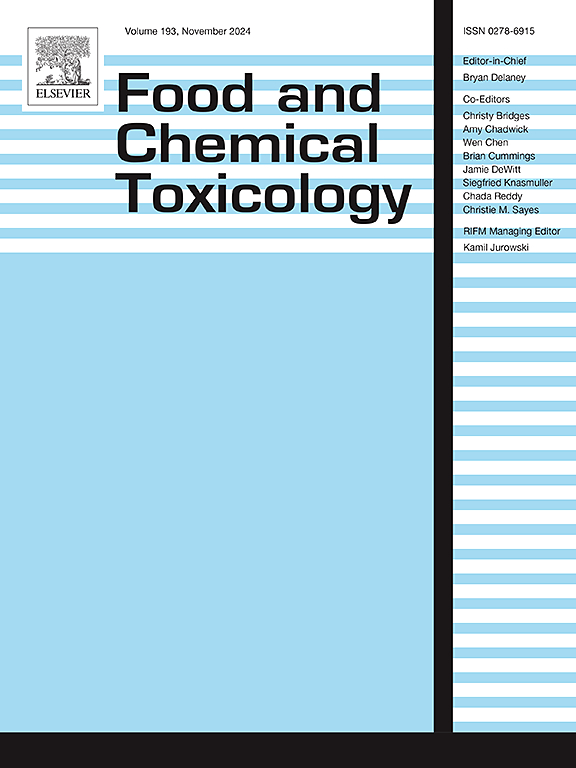Impact of endocrine disruptors on key events of hepatic steatosis in HepG2 cells
IF 3.9
3区 医学
Q2 FOOD SCIENCE & TECHNOLOGY
引用次数: 0
Abstract
Endocrine-disrupting chemicals (EDCs) may contribute to the rising incidence of metabolic dysfunction-associated steatotic liver disease (MASLD). We investigated the potential of 10 environmentally relevant EDCs to affect key events of hepatic steatosis in HepG2 human hepatoblastoma cells. Increased lipid droplet formation, a key marker of steatosis, was induced by PFOA, bisphenol F, DDE, butylparaben, and DEHP, within the non-cytotoxic concentration range of 1 nM–25 μM. Cadmium also induced this effect, but at concentrations impairing cell viability (>1 μM). At non-cytotoxic concentrations, these compounds, along with bisphenol A, dysregulated major genes controlling lipid homeostasis. Cadmium, PFOA, DDE, and DEHP significantly upregulated the DGAT1 gene involved in triglyceride synthesis, while butylparaben increased the expression of the FAT/CD36 gene responsible for fatty acid uptake. Bisphenol A downregulated the CPT1A gene involved in fatty acid oxidation. No significant effects on lipid droplet accumulation or lipid metabolism-related genes were observed for PFOS, bisphenol S, and dibutyl phthalate. Among the tested EDCs, lipid accumulation positively correlated with the expression of SREBF1, DGAT1, and CPT1A. These findings provide additional evidence that EDCs can affect MASLD and highlight the utility of in vitro methods in the screening of EDCs with hazardous steatogenic and metabolism-disrupting properties.

内分泌干扰物对HepG2细胞肝脂肪变性关键事件的影响。
内分泌干扰化合物(EDCs)可能导致代谢功能障碍相关脂肪变性肝病(MASLD)发病率上升。我们研究了10种环境相关的EDCs对HepG2人肝癌细胞肝脂肪变性关键事件的影响。PFOA、双酚F、DDE、对羟基苯甲酸丁酯和DEHP在1 nM-25 μM的无细胞毒性浓度范围内诱导脂滴形成增加,脂滴形成是脂肪变性的关键标志。镉也会引起这种效应,但浓度会降低细胞活力(>.1 μM)。在非细胞毒性浓度下,这些化合物与双酚A一起,失调了控制脂质稳态的主要基因。镉、PFOA、DDE和DEHP显著上调了参与甘油三酯合成的DGAT1基因,而对羟基苯甲酸丁酯增加了负责脂肪酸摄取的FAT/CD36基因的表达。双酚A下调参与脂肪酸氧化的CPT1A基因。PFOS、双酚S和邻苯二甲酸二丁酯对脂滴积累或脂质代谢相关基因没有显著影响。在所检测的EDCs中,脂质积累与SREBF1、DGAT1和CPT1A的表达呈正相关。这些发现提供了额外的证据,证明EDCs可以影响MASLD,并强调了体外方法在筛选具有有害脂肪生成和代谢破坏特性的EDCs方面的实用性。
本文章由计算机程序翻译,如有差异,请以英文原文为准。
求助全文
约1分钟内获得全文
求助全文
来源期刊

Food and Chemical Toxicology
工程技术-毒理学
CiteScore
10.90
自引率
4.70%
发文量
651
审稿时长
31 days
期刊介绍:
Food and Chemical Toxicology (FCT), an internationally renowned journal, that publishes original research articles and reviews on toxic effects, in animals and humans, of natural or synthetic chemicals occurring in the human environment with particular emphasis on food, drugs, and chemicals, including agricultural and industrial safety, and consumer product safety. Areas such as safety evaluation of novel foods and ingredients, biotechnologically-derived products, and nanomaterials are included in the scope of the journal. FCT also encourages submission of papers on inter-relationships between nutrition and toxicology and on in vitro techniques, particularly those fostering the 3 Rs.
The principal aim of the journal is to publish high impact, scholarly work and to serve as a multidisciplinary forum for research in toxicology. Papers submitted will be judged on the basis of scientific originality and contribution to the field, quality and subject matter. Studies should address at least one of the following:
-Adverse physiological/biochemical, or pathological changes induced by specific defined substances
-New techniques for assessing potential toxicity, including molecular biology
-Mechanisms underlying toxic phenomena
-Toxicological examinations of specific chemicals or consumer products, both those showing adverse effects and those demonstrating safety, that meet current standards of scientific acceptability.
Authors must clearly and briefly identify what novel toxic effect (s) or toxic mechanism (s) of the chemical are being reported and what their significance is in the abstract. Furthermore, sufficient doses should be included in order to provide information on NOAEL/LOAEL values.
 求助内容:
求助内容: 应助结果提醒方式:
应助结果提醒方式:


